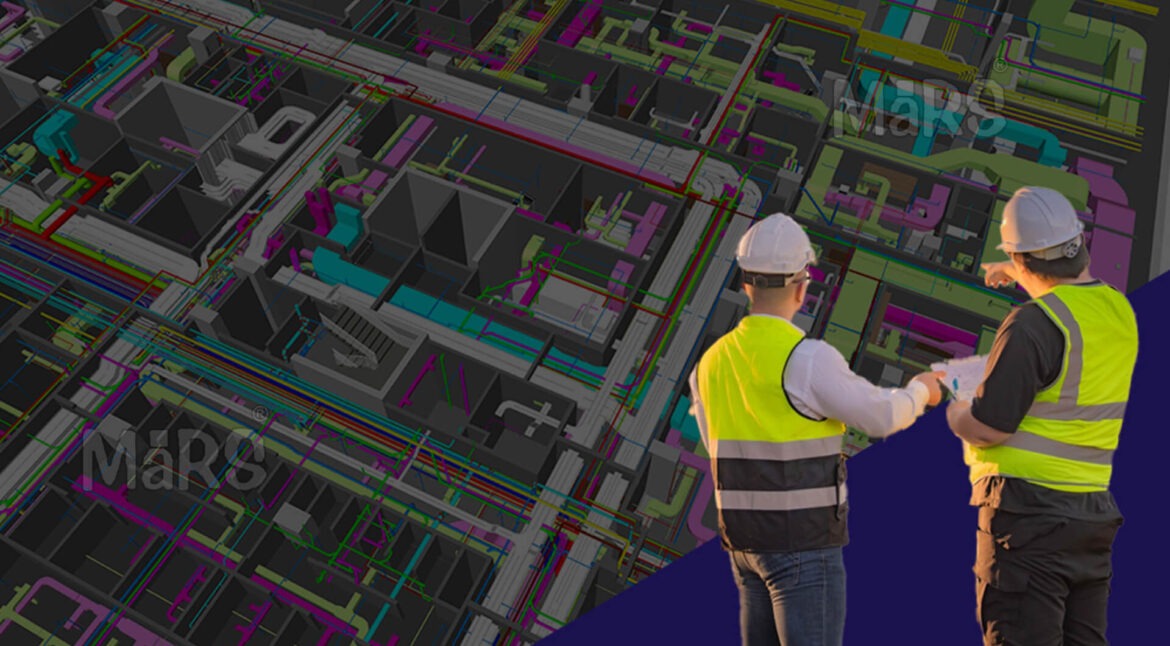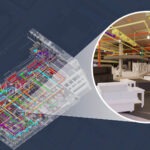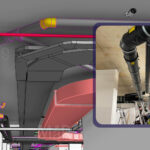Designing, implementing, and maintaining the vital systems that maintain buildings usable and functional for residents is a critical responsibility of MEP (Mechanical, Electrical, and Plumbing) engineers in the construction industry. Together, they work closely with architects, construction teams, and other experts to meet all relevant codes, regulations, and sustainability objectives while effectively integrating these essential components into the building’s design.
Throughout the construction process, MEP engineers have a variety of responsibilities, including cost estimation, construction supervision, post-occupancy maintenance, and initial site evaluation and system design. Buildings that are safe, effective, and easy to use require knowledge in areas like HVAC, electrical power and lighting, fire alarm systems, energy management, and plumbing.
MEP engineers make sure that the outcome fulfills the unique needs and requirements of the project by examining building designs, completing load calculations, choosing suitable equipment, and managing installation and testing. In addition, they take sustainability and energy efficiency into account, trying to reduce the building’s operational expenses and environmental effects.
What Does MEP Stand for in Construction?
MEP refers to the fundamental systems that enable a building’s operation in the construction industry. Electrical engineering manages power, lighting, and communication systems for effectiveness and safety, while mechanical engineering focuses on HVAC systems for indoor comfort. Appropriate waste management, drainage, and water supply are guaranteed by plumbing engineering. These fields work together to design a building’s infrastructure, making sure it complies with all applicable codes and operates as intended. This procedure is improved by the integration of MEP BIM services, which offer broad digital models that promote coordination, identify conflicts early, and boost system performance in general.
Mechanical Engineering: Mechanical engineers design and implement HVAC systems to regulate indoor climate, ensuring comfortable temperatures and proper air quality. They create heating systems for cold climates, cooling systems for hot environments, and ventilation systems to circulate air and remove pollutants. They also focus on energy efficiency and sustainability, integrating technologies that minimize energy use while maximizing comfort.
Electrical Engineering: Electrical engineers plan and install electrical systems in buildings, including power distribution, lighting, data networks, and security systems. They ensure these systems are safe, reliable, and meet operational needs while optimizing energy usage to reduce costs. Their role is essential for ensuring the proper function and safety of all electrical components.
Plumbing Engineering: Plumbing engineers design and manage systems for water supply, drainage, and waste management, ensuring efficient water distribution and proper waste disposal. They handle potable water, sanitary drainage, and stormwater systems while ensuring compliance with building codes. Their work is essential for maintaining hygiene, preventing water damage, and supporting the building’s overall functionality.
What Role Does an MEP Engineer Serve in the Construction Industry?
MEP engineers are vital to the construction industry because they concentrate on a building’s mechanical, electrical, and plumbing systems. These systems are essential to the building’s comfort, safety, and functionality. A comprehensive look at their responsibilities is provided below:
- Mechanical Systems Design and Management: MEP engineers choose equipment, design ventilation, and ductwork, and determine heating and cooling loads to design and manage HVAC systems. Ensuring a comfortable indoor climate while maximizing energy efficiency and minimizing environmental impact is their goal.
- Electrical Systems Design and Coordination: Electrical engineering within MEP focuses on designing power distribution, lighting, and control systems. MEP engineers create electrical layouts to ensure safe and efficient power delivery, integrate lighting systems, and manage data networks, all while ensuring compliance with safety standards and operational requirements.
- Plumbing Systems Design and Implementation: Water supply, drainage, and waste management system design and installation are all part of plumbing engineering. MEP engineers design plumbing and fixture layouts to guarantee their reliability, efficiency, and conformity to building regulations. Their labor is essential to preserving cleanliness and guaranteeing a functional plumbing system.
- Coordination and Integration: MEP engineers work closely with architects and structural engineers to integrate their systems into the building’s design. Using tools like MEP BIM services, they create detailed models that help identify and resolve conflicts early, enhancing project coordination and reducing costly changes during construction.
- Compliance and Quality Assurance: For MEP engineers, ensuring compliance with local building rules and regulations is essential. They maintain strict guidelines for efficiency, performance, and safety while conducting testing and audits to confirm that systems are installed and operated correctly.
- Problem-Solving and Maintenance: During and after construction, MEP engineers handle issues with mechanical, electrical, and plumbing systems, focusing on troubleshooting, repairs, and maintenance to ensure long-term performance and reliability.
What is the Difference Between BIM and MEP?
In the construction industry, MEP engineering and BIM are two separate but related concepts. Understanding the differences between them is essential to understanding how they enhance each other in the design and construction of buildings.
Building Information Modeling (BIM)
BIM is a digital modeling technology that creates a comprehensive 3D representation of a building, including architecture, structure, and systems like MEP. It integrates data into a single model, enabling advanced visualization, simulation, and analysis throughout the building’s lifecycle, from design to construction and operation.
BIM enhances collaboration by offering a unified platform for information sharing, enabling early conflict detection in the design phase to reduce errors, save time, and lower costs during construction. It also supports facility management after construction, improving building maintenance and operations.
Mechanical, Electrical, and Plumbing (MEP)
The terms mechanical, electrical, and plumbing (MEP) particularly relate to a building’s MEP systems. The comfort and functionality of a building are dependent on these systems. To meet the needs of the building for water management, electrical power, heating, and cooling, MEP engineering involves designing, installing, and maintaining these systems.
Mechanical, electrical, and plumbing systems (MEP) represent a subset of BIM, with a focus on their technical design and operation. The seamless integration of these systems with the building’s design is guaranteed by MEP engineers. They produce detailed MEP system models with BIM tools, which are then integrated into the overall building model.
Conclusion
The role of an MEP engineer is crucial to any building project, focusing on the design and management of mechanical, electrical, and plumbing systems. They ensure that HVAC, electrical distribution, and plumbing systems function efficiently, comfortably, and safely. By closely coordinating with architects and other engineers, MEP professionals integrate these systems into the building design and resolve potential issues early on.
Their work enhances building functionality, comfort, and sustainability while improving energy efficiency. By using advanced technologies like MEP BIM services, they can model system performance, detect conflicts, and optimize designs, leading to greater accuracy, fewer errors, and cost savings during construction.
Ultimately, MEP engineers play a vital role in ensuring buildings meet high standards of performance and user satisfaction. Their contributions create functional spaces that adapt to the evolving needs of occupants.
Frequently Asked Questions About MEP Engineering
What does MEP stand for in construction?
MEP stands for Mechanical, Electrical, and Plumbing. These disciplines focus on designing and managing the essential systems within a building, including HVAC systems, electrical power distribution, lighting, water supply, and drainage.
What is the role of an MEP engineer?
An MEP engineer designs, coordinates, and oversees the installation of mechanical, electrical, and plumbing systems in a building. They ensure these systems operate efficiently, meet building codes, and integrate seamlessly with the overall design of the building.
How does MEP engineering contribute to building efficiency?
MEP engineering enhances building efficiency by designing systems that optimize energy use, maintain comfortable indoor environments, and ensure effective water management. By integrating advanced technologies and adhering to best practices, MEP engineers help reduce operational costs and improve sustainability.
What is MEP BIM, and how does it benefit construction projects?
MEP BIM is a digital modeling process that creates detailed 3D representations of mechanical, electrical, and plumbing systems. It benefits construction projects by improving coordination, detecting potential conflicts early, and facilitating better communication among stakeholders. This leads to fewer errors, cost savings, and more efficient construction processes.
Why is MEP coordination important in construction?
MEP coordination is crucial because it ensures that mechanical, electrical, and plumbing systems are integrated properly within the building’s design. Effective coordination helps prevent conflicts between systems, avoid costly redesigns, and ensure that all systems function harmoniously.
What are some common challenges faced by MEP engineers?
Common challenges include managing complex system integrations, ensuring compliance with ever-changing building codes, addressing design conflicts, and optimizing systems for energy efficiency. MEP engineers must also adapt to new technologies and address unexpected issues during construction.
How do MEP engineers ensure compliance with building codes and regulations?
MEP engineers stay updated on local and national building codes and regulations. They design systems that adhere to these standards, conduct regular inspections and tests, and work closely with regulatory authorities to ensure compliance throughout the construction process.
Can MEP engineers help with building retrofits and renovations?
Yes, MEP engineers play a key role in building retrofits and renovations. They assess existing systems, design upgrades or replacements, and ensure that new systems integrate seamlessly with the existing infrastructure. Their expertise is crucial for improving the efficiency and functionality of older buildings.
What software tools do MEP engineers use?
MEP engineers use a variety of software tools for design and modeling, including AutoCAD, Revit, and other BIM software. These tools help in creating detailed system designs, conducting simulations, and coordinating with other disciplines.
How does MEP engineering impact building sustainability?
MEP engineering impacts building sustainability by designing systems that reduce energy consumption, minimize waste, and improve overall efficiency. Engineers implement energy-efficient technologies, use sustainable materials, and optimize system performance to enhance the building’s environmental footprint.
What is the importance of maintenance in MEP engineering?
Maintenance is crucial in MEP engineering to ensure that systems continue to operate efficiently and effectively throughout their lifecycle. Regular maintenance helps prevent breakdowns, extend the lifespan of systems, and address any issues that may affect performance or safety. MEP engineers may develop maintenance schedules and recommend best practices for system upkeep.
What is the impact of new technologies on MEP engineering?
New technologies impact MEP engineering by providing advanced tools and solutions for system design, analysis, and management. Innovations such as smart building systems, energy modeling software, and advanced BIM tools enhance the efficiency, accuracy, and sustainability of MEP designs. MEP engineers must stay abreast of these technologies to incorporate them effectively into their projects.




